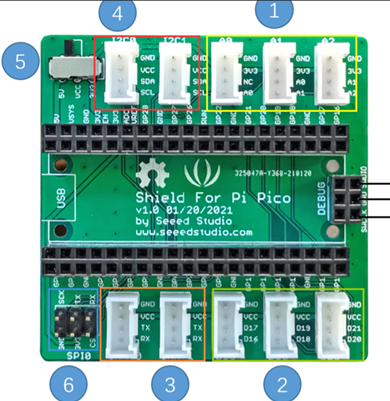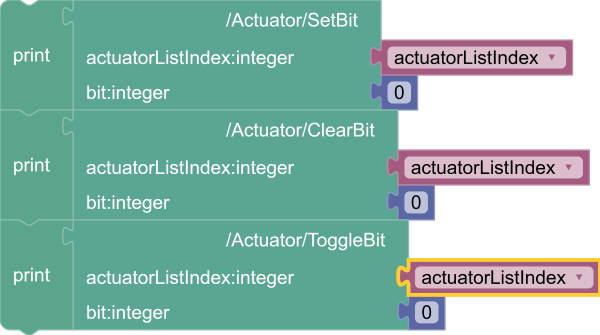Softata: Added Actuator Class - Relay
A new specific actuator device class has been added to Softata: The Grove Relay.
This relay was previously used with the Softata Console app but was coded purely as a digital on/off device. This abstracts it leading to its use in the Blockly code and with remote activation via Azure IoT Hub using a Cloud to Device message.
About

The Grove Relay plugs into the Grove RPi Pico Shield in one of the three sockets at the bottom (sockets 3 to 5, group 2 below). The third socket is the default which connects to Pico using pin 16.

The other 2 sockets use pins 18 and 20.
Blockly Setup
You can use the default setup which uses pin 16/the third socket:

Or you can use the general setup, say, using the fourth socket/pin 18:

Note in both cases, the returned actuatorListIndex value from the instantiation. This is then used in the Relay Actions.
SoftataLib Actuator.Relay Setup c# Code
In the updated Console app:
byte relayPin = 16;
byte actuatorIndex = 0;
switch (potRelaySelection)
{
case 1:
//Previous digital mode
SoftataLib.Digital.SetPinMode(RELAY, SoftataLib.PinMode.DigitalOutput);
break;
case 2:
actuatorIndex = SoftataLib.Actuator.SetupDefault(SoftataLib.Actuator.ActuatorDevice.Relay);
break;
case 3:
relayPin = 18;
actuatorIndex = SoftataLib.Actuator.Setup(SoftataLib.Actuator.ActuatorDevice.Relay, relayPin);
break;
case 4:
relayPin = 20;
actuatorIndex = SoftataLib.Actuator.Setup(SoftataLib.Actuator.ActuatorDevice.Relay, relayPin);
break;
}
- Case 2 uses the default Actuator.Relay setup (pin 16).
- Cases 3 and 4 explicitly set the pin 18/20 using the non-default Actuator.Relay setup.
Blockly Relay Actions
You can set, reset and toggle the state of the relay once instantiated:

Note: The bit parameter is dummy but required; zero here. It has no bearing on the functionality.
SoftataLib Actuator.Relay Actions C# Code
Note: The
actuatorIndexreturned from the relay class instantiation when added to the Actuators linked list.
And also not the “dummy” bit number of 0.
SoftataLib.Actuator.SetBit(actuatorIndex,0);
Setting the relay
SoftataLib.Actuator.ClearBit(actuatorIndex, 0);
Clearing/resetting the relay
SoftataLib.Actuator.ToggleBit(actuatorIndex, 0);
Toggling the relay
Cloud to Device Relay Messages
As per previous post :Softata - Cloud 2 Device Messages 2
Can send C2D messages using amongst other tools: Azure IoT Explorer
The C2D message is a string. Properties etc are ignored.
- The first character determines the command, and is case insensitive alpha.
- The last character (if numeric) is interpreted as the device linked list index.
-
The second last character (if numeric), is a dummy parameter, but is required. Iis ignored.
- Actuator01: Set the relay of index 1
- Reset01: Reset the relay of index 1
- Toggle01: Toggle the relay of index 1
eg: A00 Set the relay with index 0.
Conclusion
Whilst the discussion here has been about orchestrating a Grove Relay, the connected actuator could also be an LED, Buzzer, simple DC motor etc. Anything that gets turned on or off and manifests as a single bit.
| Topic | Subtopic | |
| Next: > | App Settings for a .NET Console App | Save, Retrieve and Validate IPAddress and Port |
| This Category Links | ||
| Category: | Softata Index: | Softata |
| Next: > | Softata | A Quick Start with Blockly |
| < Prev: | Softata | Cloud 2 Device Messages 2 |




